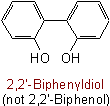
ACD/Name (Chemist Version) offers a standardized set of features for quick and simple generation of IUPAC names, and structures from names. It is a streamlined version of our popular ACD/Name software.
View a full description and pricing on our web store.

71.2 - Radicals derived from unsubstituted ring assemblies are named by adding "-yl", "-ylene" or "-diyl", or "-triyl", etc., to the name of the assembly, with elision of a terminal "e" (if present) before "yl" or, "ylene". Radical positions have numbers as low as permitted by the fixed numbering of the assembly. (cf. Rules A-55.1 and B-13).Examples to Rule C-71.1
71.3 - (Partially alternative to Rule C-71.4) - Derivatives of ring assemblies are named systematically with the principal group added as suffix to the name of the ring assembly and any other substituents are named as prefixes. The points of union of the cyclic components are given the lowest possible numbers consistent with the numbering of the ring systems; if a choice remains, the principal groups, and thereafter the other substituents, are given the next lowest permissible numbers. When necessary, the name and the prefixed numbers of the ring assembly are placed in brackets, to denote that the syllables "bi-", "ter-", etc., do not multiply the suffixes.Examples to Rule C-71.2
71.4 - (Alternative to part of Rule <C-71.3) - When identical component molecules have trivial names that include the principal groups, their union by a single or double bond is denoted by placing the prefix "bi-" in front of the trivial name. The numbering of the individual component is retained and the point of union has the lowest number that is permissible thereafter. Locants for the points of union are placed before "bi-", and one is primed (the higher if they are different).Examples to Rule C-71.3
Exceptions: This rule is not applied to biphenyl derivatives. ThusExamples to Rule C-71.4

71.5 - When directly linked units contain principal groups in unequal numbers, all the principal groups are cited (with locants) as suffixes to the name of the assembly. The name of the assembly is placed in square brackets when ambiguity might otherwise arise.
See Recommendations'93 R-2.4.4 and R-1.2.8Examples to Rule C-71.5



Published with permission of the IUPAC by Advanced Chemistry Development, Inc., www.acdlabs.com, +1(416)368-3435 tel, +1(416)368-5596 fax. For comments or suggestions please contact webmaster@acdlabs.com